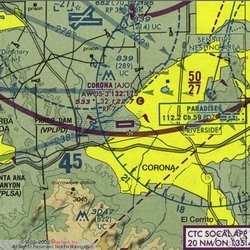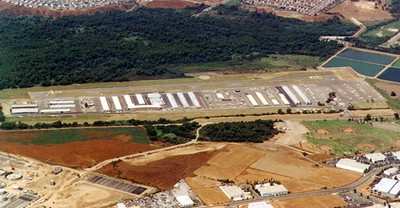Notes Neither Plane Attempted To Avoid Collision
 Editor's Note
-- This week, the National Transportation Safety Board released its
Preliminary Report on the January 20 midair collision between two
Cessna high-wing aircraft over Corona, CA. The
unedited text of the report follows below.
Editor's Note
-- This week, the National Transportation Safety Board released its
Preliminary Report on the January 20 midair collision between two
Cessna high-wing aircraft over Corona, CA. The
unedited text of the report follows below.
Notably, the NTSB states the collision occurred as one of
the aircraft, a C-172, apparently entered the left-hand traffic
pattern for Corona Municipal Airport. That plane collided with a
C-150, reportedly established on the downwind for runway
25.
The aircraft collided about 1.4 miles SSW of the airport.
Eyewitnesses said neither aircraft maneuvered in the seconds
leading up to the collision, and neither aircraft made any attempt
to avoid the other.
NTSB Identification: LAX08FA049A
14 CFR Part 91: General Aviation
Accident occurred Sunday, January 20, 2008 in Corona, CA
Aircraft: Cessna 172N, registration: N737EJ
Injuries: 5 Fatal.
NTSB Identification: LAX08FA049B
14 CFR Part 91: General Aviation
Accident occurred Sunday, January 20, 2008 in Corona, CA
Aircraft: Cessna 150M, registration: N4008V
Injuries: 5 Fatal.
This is preliminary information, subject to change, and may
contain errors. Any errors in this report will be corrected when
the final report has been completed.
 On January 20, 2008,
about 1534 Pacific standard time, a Cessna 172N, N737EJ, and a
Cessna 150M, N4008V, collided in flight while approaching runway 25
at the Corona Municipal (uncontrolled) Airport, Corona, California.
The midair collision occurred at a location and flight direction
consistent with the Cessna 172N entering the left-hand traffic
pattern, and the Cessna 150M being in the pattern's downwind leg,
about 1.4 miles south-southwest of the airport. The commercial
certificated pilot flying the Cessna 172N and his passenger were
killed. The two private pilots in the Cessna 150M and a person on
the ground were also killed. Both airplanes were fragmented during
the midair collision and were subsequently destroyed upon falling
nose down into buildings, automobiles, and parking lots. The Cessna
172N was operated by Funoutside, based in Fullerton, California.
The Cessna 150M was operated by Corona Flight Academy, based in
Corona. The flights were performed under the provisions of 14 Code
of Federal Regulations Part 91. Visual meteorological conditions
prevailed at the time, and no flight plans were filed. The purpose
of the Cessna 172N's flight has not been determined, and the
purpose of the Cessna 150M's flight was personal. The locations and
times that the airplanes departed for the accident flight have not
been determined.
On January 20, 2008,
about 1534 Pacific standard time, a Cessna 172N, N737EJ, and a
Cessna 150M, N4008V, collided in flight while approaching runway 25
at the Corona Municipal (uncontrolled) Airport, Corona, California.
The midair collision occurred at a location and flight direction
consistent with the Cessna 172N entering the left-hand traffic
pattern, and the Cessna 150M being in the pattern's downwind leg,
about 1.4 miles south-southwest of the airport. The commercial
certificated pilot flying the Cessna 172N and his passenger were
killed. The two private pilots in the Cessna 150M and a person on
the ground were also killed. Both airplanes were fragmented during
the midair collision and were subsequently destroyed upon falling
nose down into buildings, automobiles, and parking lots. The Cessna
172N was operated by Funoutside, based in Fullerton, California.
The Cessna 150M was operated by Corona Flight Academy, based in
Corona. The flights were performed under the provisions of 14 Code
of Federal Regulations Part 91. Visual meteorological conditions
prevailed at the time, and no flight plans were filed. The purpose
of the Cessna 172N's flight has not been determined, and the
purpose of the Cessna 150M's flight was personal. The locations and
times that the airplanes departed for the accident flight have not
been determined.
Dozens of eyewitnesses, located within 1 mile around the
accident site, reported observing and/or hearing the midair
collision. The National Transportation Safety Board investigator
interviewed one witness who was located on a hillside about 0.5
mile southwest of the accident site. This witness reported
continuously observing both airplanes cruising toward each other
for at least 5 seconds preceding the collision. The witness stated
that one airplane was flying in a northerly direction toward the
Corona Airport, while the other airplane was flying in an easterly
direction, just south of the airport. No maneuvering was observed
during the seconds immediately prior to the impact. According to
the witness, upon colliding, parts of the airplanes separated from
each other, and the parts looked like wings.
The Safety Board investigator's on scene examination of the
wreckage revealed fragmented components of the Cessna 150M along a
300-foot-long path. The principal axis of the wreckage distribution
was about 70 degrees. Beginning at the western side of this
wreckage path, the first 2 airframe structural components found
were the left and right wings, which were separated from the
fuselage. Most of the empennage was located east of the wings. The
top of the Cessna 150M's vertical stabilizer and rudder assembly
were found separated from and south of the main portion of the
empennage. Most of the cockpit, firewall, and attached engine
assembly were located at ground level inside a building, which bore
an engine-sized hole in its roof, at the extreme eastern side of
the wreckage distribution path. Instruments from the airplane were
located on the roof and inside the building.
A fragment of Cessna 172N structure was located several yards
from the Cessna 150M's wings. The main Cessna 172N wreckage was
located on the ground about 800 feet north-northeast of the Cessna
150M's wings. Portions of both airplanes (landing gears, fuselage
skin, instruments) were found commingled at this location. The
principal axis of the Cessna 172N's wreckage distribution path was
about 025 degrees.
During the on-scene wreckage examination of both airplanes,
evidence of fuel was observed, and the wing flaps were found
retracted. There was no evidence of fire.

All of the airplane wreckage has been recovered from the
accident site, and an examination for contact evidence between the
airplanes is ongoing. Preliminary observations revealed the
presence of paint transfer and scratch mark signatures on skin
panels, and laceration evidence in structural components.
Laceration signatures consistent with propeller blade
penetration marks were observed on the lower portion of the Cessna
150M's severed right wing lift strut, right cockpit floor, and
right seat.
The bottom of the Cessna 172N's white painted left wing bore a
series of scratch marks and paint transfer signatures consistent
with blue painted portions of the Cessna 150M's fuselage. A several
inch-long span in the leading edge of one of the Cessna 172N's
propeller blades was found dented. The dent was consistent with the
size of the Cessna 150M's severed wing lift strut.
The orientation of the scratch marks between the airplanes and
the penetration evidence is being documented to determine the
respective collision and convergence angles.
About the time of the accident, 2 other pilots were flying in
the vicinity of Corona. The pilots reported that runway 25 was in
active use.
 ANN's Daily Aero-Linx (04.13.24)
ANN's Daily Aero-Linx (04.13.24) ANN's Daily Aero-Term (04.13.24): Beyond Visual Line Of Sight (BVLOS)
ANN's Daily Aero-Term (04.13.24): Beyond Visual Line Of Sight (BVLOS) Airborne 04.09.24: SnF24!, Piper-DeltaHawk!, Fisher Update, Junkers
Airborne 04.09.24: SnF24!, Piper-DeltaHawk!, Fisher Update, Junkers Aero-News: Quote of the Day (04.14.24)
Aero-News: Quote of the Day (04.14.24) ANN's Daily Aero-Term (04.14.24): Maximum Authorized Altitude
ANN's Daily Aero-Term (04.14.24): Maximum Authorized Altitude





